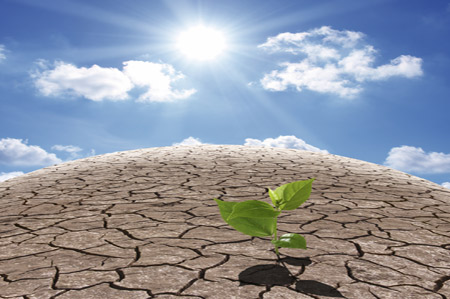 (Bloomberg) – Corn futures rose to a 10-month high and soybeans extended a rally to the costliest since 2008 on speculation that an expanding drought will cut supplies from the U.S., the world’s biggest producer of the crops.
(Bloomberg) – Corn futures rose to a 10-month high and soybeans extended a rally to the costliest since 2008 on speculation that an expanding drought will cut supplies from the U.S., the world’s biggest producer of the crops.
Most of the Midwest will be unusually dry and hot in the next 10 days as occasional showers will be too light to induce more than brief crop improvement, T-Storm Weather LLC in Chicago said in a report. July is on pace to rank as the third driest and warmest in 118 years of data, the private forecaster said. Soybean-meal futures climbed to a record.
Farmer Albert Walsh holds an underdeveloped ear of field corn as he walks through a drought damaged field in Carmi, Illinois. Photographer: Daniel Acker/Bloomberg
“The crops are shrinking daily, and the market is pricing in the risk for less available supply for export and domestic usage,” Jim Gerlach, the president of A/C Trading Inc. in Fowler, Indiana, said in a telephone interview. “The path of least resistance is for higher prices until the crops get enough rain to stabilize yields. Demand is already starting to slow.”
Corn futures for December delivery jumped 4.4 percent to close at $7.725 a bushel at 2 p.m. on the Chicago Board of Trade, the biggest gain in a week. Earlier, the price reached $7.78, the highest for a most-active contract since Aug. 29. The grain used to make food, animal feed and ethanol fuel has surged 53 percent since June 15 as the hot, dry weather intensified.
Soybean futures for November delivery rose 2.4 percent to $15.905 a bushel on the CBOT. Earlier, the price reached $15.985, the highest since July 2008.
Soybean-meal futures for December delivery gained 2.3 percent to $463.80 per 2,000 pounds in Chicago. Earlier, the commodity, used in livestock feed, reached a record $470.70.
About 63 percent of the Midwest, where farmers harvested 60 percent of last year’s U.S. crop, had moderate to extreme drought conditions as of July 10, the highest since the government-funded U.S. Drought Monitor in Lincoln, Nebraska, began tracking the data in 2000. About 40 percent of the nation’s corn and soybeans were in good or excellent condition as of July 8, the lowest for that date since 1988, government data show.
To contact the reporter on this story: Jeff Wilson in Chicago at jwilson29@bloomberg.net
To contact the editor responsible for this story: Steve Stroth at sstroth@bloomberg.net




